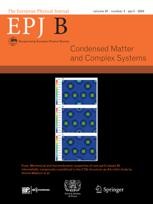Understanding changes in a non-equilibrium economy
A novel theory can link abrupt, non-equilibrium changes to the state of the economy to a central principle of dynamics and thermodynamics
New York | Heidelberg, 1 February 2022
 Equilibrium is a fundamental concept in economics: describing situations where the many interacting variables governing the state of the economy are static and perfectly balanced. Yet in reality, the inherent uncertainty and randomness associated with these variables, combined with the fragility of economists’ expectations, mean that the economy can never really be in true equilibrium. In new research published in EPJ B, a research team led by Kun Zhang from the Changchun Institute of Applied Chemistry of the Chinese Academy of Sciences, and Jin Wang at State University of New York at Stony Brook, use new mathematical theories to capture the economy’s true non-equilibrium nature and to show how it can be quantified.
Equilibrium is a fundamental concept in economics: describing situations where the many interacting variables governing the state of the economy are static and perfectly balanced. Yet in reality, the inherent uncertainty and randomness associated with these variables, combined with the fragility of economists’ expectations, mean that the economy can never really be in true equilibrium. In new research published in EPJ B, a research team led by Kun Zhang from the Changchun Institute of Applied Chemistry of the Chinese Academy of Sciences, and Jin Wang at State University of New York at Stony Brook, use new mathematical theories to capture the economy’s true non-equilibrium nature and to show how it can be quantified.
Using their theory, Wang and Zhang’s team hope that economists could better predict periods of economic crisis or catastrophe. In principle, an equilibrium economy can be reached if supply and demand are perfectly matched – so that any shift in either supply or demand will trigger a transformation to another state of equilibrium. More realistically, abrupt changes like the breakdown of financial markets may occur, which can drastically alter the supply-demand curve, giving rise to either oscillations, or bifurcations into new monostable or bistable states. These behaviours can’t be understood within an equilibrium framework – leading to critical questions as to how different economic states emerge, and how they dynamically transform from one to the other.
To achieve this understanding, the team’s mathematical ‘landscape and flux’ theory quantifies non-equilibrium states, by focusing on critical points where transformations between states occur as the supply-demand curve changes. Wang, Zhang and colleagues discovered that these changes can be understood dynamically in terms of the nonequilibrium ‘rotational flux’, which destabilizes the current state; and thermodynamically, in terms of entropy production. This entropy is the cost of the nonequilibrium process, and is closely associated with the rotational flux. The insights provided by this theory may help economists to identify when the abrupt economic changes are about to occur, potentially giving us vital time to prepare.
References: K Zhang, E Wang, J Wang (2021), Searching for the physical origin of bifurcations in non-equilibrium economy, European Physical Journal B 94:213, DOI: https://doi.org/10.1140/epjb/s10051-021-00218-4
Further Information
For more information visit: www.epj.org
Services for Journalists
The full-text article is available here.
Contact
Sabine Lehr | Springer | Physics Editorial Department
tel +49-6221-487-8336 | sabine.lehr@springer.com
